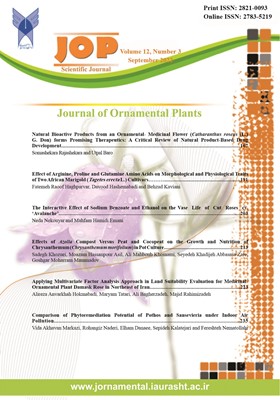-
-
فهرست مقالات
-
دسترسی آزاد مقاله
1 - Natural Bioactive Products from an Ornamental- Medicinal Flower (<i>Catharanthus roseus</i> (L.) G. Don) forms Promising Therapeutics: A Critical Review of Natural Product-Based Drug Development
Somashekara Rajashekara Utpal Baro -
دسترسی آزاد مقاله
2 - Effect of Arginine, Proline, and Glutamine Amino Acids on Morphological and Physiological Traits of Two African Marigold (<i>Tagetes erecta</i> L.) Cultivars
Fatemeh Raoof Haghparvar Davood Hashemabadi Behzad Kaviani -
دسترسی آزاد مقاله
3 - The Interactive Effect of Sodium Benzoate and Ethanol on the Vase Life of Cut Roses cv. ‘Avalanche’
Neda Nekouyar Mahfam Hamidi Emani -
دسترسی آزاد مقاله
4 - Effects of Azolla Compost Versus Peat and Cocopeat on the Growth and Nutrition of Chrysanthemum (<i>Chrysanthemum morifolium</i>) in Pot Culture
Sadegh Khozuei Moazam Hassanpour Asil Ali Mahboub Khomami Seyedeh Khadijeh Abbasnia Zare Goshgar Moharram Mammadov -
دسترسی آزاد مقاله
5 - Applying Multivariate Factor Analysis Approach in Land Suitability Evaluation for Medicinal- Ornamental Plant Damask Rose in Northeast of Iran
Alireza Anvarkhah Hakmabadi Maryam Tatari Ali Bagherzadeh Chaharjoui Majid Rahimizadeh -
دسترسی آزاد مقاله
6 - Comparison of Phytoremediation Potential of Pothos and Sansevieria under Indoor Air Pollution
Vida Akhavan Markazi Rohangiz Naderi Elham Danaee Sepideh Kalatehjari Fereshteh Nematollahi
-
حقوق این وبسایت متعلق به سامانه مدیریت نشریات دانشگاه آزاد اسلامی است.
حق نشر © 1404-1400







